| Cím: | Solutions for the Problems of the József Kürschák Mathematics Competition, 2002 | |
| Szerző(k): | Gyula Károlyi | |
| Füzet: | 2004/februári melléklet, 3 - 13. oldal |  PDF | MathML PDF | MathML |
|
A szöveg csak Firefox böngészőben jelenik meg helyesen. Használja a fenti PDF file-ra mutató link-et a letöltésre. Problem 1. The sides of an acute-angled triangle are pairwise different, its orthocentre is , the centre of its inscribed circle is , and the centre of its circumscribed circle is . Prove that if a circle passes through the points , , and a vertex of the triangle, then it also passes through another vertex. Solution 1. The points , , lie in the interior of the triangle. If the vertices are denoted by , , and the corresponding angles by , , , then . The second equality is true because in the isosceles triangle , , since the angle at the centre is twice the angle at the circumference. The line bisects the angle , so the rays and lie symmetrically on either side of the ray . The three rays do not coincide (or else the triangle would be isosceles). Thus the line segments and subtend equal angles at the vertex , and the line separates the points and . It is clear that this statement remains valid if we replace with any other vertex of the triangle. Assume now that the points , , , are concyclic. Being so, the converse of the theorem about angles at the circumference implies that the line segments and are equal. As we have seen, they subtend equal angles at the vertices of the triangle. Let us examine, therefore, the locus of the points where the two edges subtend equal angles. 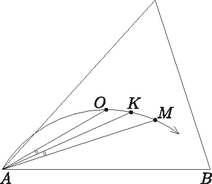 If that angle is for a given , then lies on one of the two arcs where the segment subtends an angle , and also on one of the two arcs where the segment subtends an angle . Let these arcs be and , respectively. We will call the arc an inward arc if the arc lies on the same side of the line as the point , and an outward arc if they lie on the opposite side. There will be no ambiguity, since the points , , cannot be collinear. This terminology can be extended to the arc as well, if we interchange the roles of points and . If both and are outward arcs, their intersection (if any) lies on the perpendicular bisector of the line segment , since the two arcs are congruent due to . The same holds if both arcs are inward ones. The only exception is the case when the two arcs have at least two further common points in addition to their common endpoint . This happens if and only if the two arcs are incident to the same circle, that is the circle through the points , , . Is it possible that we have one outward arc (say, the arc ) and one inward arc? In that case, the two arcs intersect each other if and only if is smaller than the angle . Then intersects the extension of the ray beyond . At that point and subtend equal angles, so that point must be the intersection of the two arcs. Such a point, however, cannot be a vertex of the triangle , since a circle through that vertex and would not separate the points and . 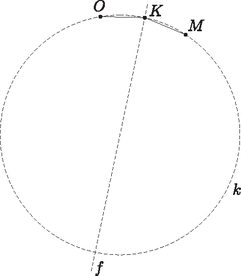 We can conclude that each vertex of the triangle lies either on the line or on the circle . Since the point lies on , at most one of the vertices may lie on , and thus at least two of them must lie on the circle . The claim is hence proved. Consider the intersection of the angle bisector of the angle with the circle circumscribed about the triangle . The converse of the theorem about the angles subtended at the circumference of a circle implies , that is, the point lies on , too. As shown in the first part of the previous proof, the point also lies on the lines and . Therefore, if the lines and do not coincide, then , that is, the points , , , all lie on the circle . Since the points , , are different, and must be identical, and thus passes through the vertex as well. 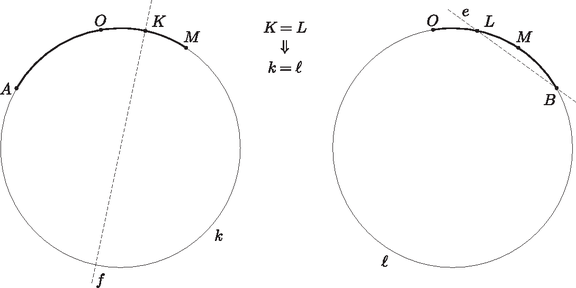 If the lines and coincide, then passes through the vertex , that is, , where is the radius of the circumcircle of the triangle . If is the perpendicular projection of on the side , then 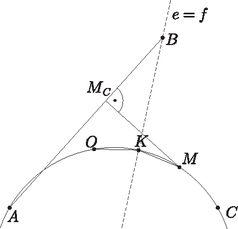 Solution 3 (based on the solution by Harangi, Viktor). As seen above, the points , , are different, and the line does not pass through any vertex of the triangle. Assume that the line separates the vertex from the other two. Then the perpendicular bisector of the line segment (which passes through the point ) must intersect the side , otherwise one of the points and (say, ) would lie closer to each of the points and than the other one. Since lies on both the bisector of the angle and that of the angle , and an angle bisector divides the opposite side in the ratio of the adjacent sides, it follows that both of the lines and would intersect the line segment closer to its endpoint , and thus would also lie closer to than . That is contradiction. Thus one of the vertices and lies on the same side of the line as the point , and the other one lies on the same side as . Without loss of generality, we may assume that and , where at least one of these relations is a strict inequality. Therefore the line intersects the line segment closer to , and the line intersects it closer to . (One, but not both of the intersections may coincide with the midpoint of the edge ). Consequently, the line separates the point from the vertices and . We can establish, therefore, that both vertices and lie between the arms of the angle . Reflect now the point in the line to get the point . Since , and and are on the same side of the line , the points , , , are clearly concyclic, and for symmetry reasons their circle also passes through the point . Thus lies on the circumscribed circle of the triangle . For the same reason, vertex is also incident to this circle but vertex is not, since the line does not separate the points and . That completes the proof. 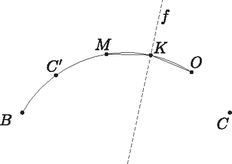 Remarks. Is it a necessary condition that the sides of the triangle are pairwise different? If the triangle is isosceles, then the points , , are collinear. A circle can pass through all these points only if two of them coincide, that is, if the triangle is equilateral. Thus it would have been enough to require that the triangle is a non-equilateral acute-angled triangle. If the triangle is not acute-angled, it cannot be equilateral either, and such a restriction is not needed. If the triangle is right-angled, the point coincides with a vertex. Thus if a circle passes through the points , , , then it necessarily passes through a vertex of the triangle. However, it can pass through another vertex only if the third angle is . (Why?) The statement is hence not true for right triangles. And what about an obtuse triangle? In that case the solution is more complicated, but the claim still holds. 1) The orthocentre of an obtuse-angled triangle is , the centre of its inscribed circle is , and the centre of its circumscribed circle is . Prove that if a circle passes through the points , , and a vertex of the triangle, then it also passes through another vertex. 2) If a triangle is not right-angled, then there exists a circle passing through the points , , and a vertex if and only if one angle of the triangle is . Let , and assume that , and the positive integers and satisfy Adding the two results yields The same reasoning applies when If then , and if then . If we go on checking the values of , we find alternating values of and , that is, . This is true for , and if it holds for some integer , then it follows that Since in our case and are both positive, must also be positive and thus its value is 1, as we set out to prove. A similar argument works if Consider the fraction which is smaller than . If If , then for and are relatively prime. This is shown as follows: if a positive integer divides both and , then it also divides their difference , and so on, divides all the numbers . Since , must be 1. There remains the case A similar argument yields the claim if is odd. Several papers used the theory of the Farey sequence. Here is an example. Note that and are consecutive terms of the sequence . This is the case if , and if and are consecutive terms of for an integer , then the fraction inserted between them in the next sequence is equal to Since is strictly increasing, the fraction is greater than 1. According to the above properties, the fraction thus occurs in some sequence , reduced to lowest terms in a form . Since is greater then one of the fractions and and smaller than the other one, clearly . The construction of the sequences implies that the numerator of every fraction inserted between and is at least , and hence Remark. In this solution, a sledgehammer was used to crack a nut, since the proofs of the stated properties of Farey sequences are actually based on considerations contained in the previous solutions. Solution 1 (based on the solution by Csikvári, Péter). Let us assign to the vertices of the polygon the numbers , written in base-3 notation. Each number consists of digits at most. If the number of digits is less than , then adding leading zeros we have a sequence of digits of 0, 1 or 2. In other words, we assign to the vertices of the polygon those sequences of length whose terms are either 0, 1, or 2. Consider the triangles satisfying the following condition: Whichever position is chosen from the first to the -th, the three numbers assigned to the vertices of the triangle either have the same digit at the given position, or all three of them have different digits at that position. It is clear that for any pair of vertices of the polygon there is exactly one additional vertex available such that the three of them satisfy the above condition. Thus every single side and diagonal of our polygon is the side of exactly one such triangle, and hence the sets of three edges forming the sides of such triangles will have the required property. The rest of the edges can be grouped as follows: The edges , and are put together whenever is divisible by . It is clear that three such edges form a triangle. On the other hand, if any two of the numbers , , are fixed, the divisibility condition uniquely determines the third one, and hence every edge occurs in exactly one triplet. The statement is hence true for , and the induction step is complete. Let , , () denote the vertices of a convex -gon. Consider the triangles where , and call them triangles of the first kind. Consider now each triangle of the above partition, and construct the triangles , , (second kind) and the triangles , , , , , (third kind). One gets It is clear that triangles of the first kind have no vertex in common at all, and they cannot have more than one common vertex with any triangle of the second kind either. Two triangles of the second kind either have no common vertex, or by the induction hypothesis they have at most one such vertex. Triangles of the third kind may have at most one vertex in common with triangles of the other two kinds. Finally, two triangles of the third kind may have at most one common vertex. This follows from the induction hypothesis, since if, say, and are both triangles of the third kind, then the partition of the original -gon must have contained both the triangles and . That can only happen if . Consider the symmetry axis of the polygon through a vertex marked . Since has an odd number of vertices, this axis does not contain any other vertex. The image after a reflection of a vertex marked about the axis is another vertex marked , that of a reflection of a vertex marked is a vertex marked , and that of a reflection of a vertex marked is a vertex marked . Similarly, if the axis is through a vertex marked or , it is the vertices marked and , respectively, that map onto vertices of the same kind. We proceed now as follows: the edges of a triangle of type are grouped together if and only if the triangle is symmetrical about the axis of the polygon passing through the vertex . We show that every edge of type , or of the polygon is used exactly once, which means that the induction works. An edge of type belongs exactly to one such triangle, the one whose third vertex is obtained by reflecting about the axis through . The image will be a vertex of type as said above. By symmetry, each edge of type belongs to exactly one triangle as well. Finally, consider an edge of type . Its perpendicular bisector is a symmetry axis of , so it passes through a particular vertex of , which must be a vertex of type for the reasons mentioned above. That vertex, and only that may be the third vertex of the required triangle. Finally, let us examine the solution that reveals the genuine geometrical (or algebraic, if you like) background of the problem. The required partition can be accomplished in terms of the lines of the -dimensional affine space over the three-element field. The argument below will hopefully reveal the point of the story. Consider the sequences where, for every , is a non-negative integer less than . The number of such sequences is clearly . They represent the points of the -dimensional affine space over the -element field, which we will identify with the vertices of the given complete graph. We may also think of them as vectors, similar to the way the position vectors are identified with their endpoints in 3-dimensional Euclidean space. The sum of two points and is defined as How can we define a line through two different points and ? Let us add the multiples of the vector to the point , as we would do in the Euclidean case. It is easy to show that any such line consists of distinct points. On one hand, there may be at most points on the line since it is enough to add the vector to the point times. On the other hand, if for two different numbers then modulo for each coordinate of . Thus is divisible by , which can only happen if every is zero. That contradicts and being different points. Any pair of distinct points determine a line passing through exactly points. The crucial observation is that any pair of different lines have at most one point in common, or in other words, any pair of points belong to exactly one line. Hence the statement follows: the complete graphs on points to be found correspond to the different lines. 1) Prove that the roles of and can be interchanged in the definition of the line through and . 2) Prove that if and are two different points of the line through the points and , then and lie on the line determined by and . How does this imply the ``crucial'' observation mentioned in the solution? 3) How can we define two lines to be parallel? 4) How can planes be defined? How many points will a plane have? What would the set of common points of two planes look like? 5) What problems would we face if, formulating the statement of the above general theorem with a composite number in the place of the prime , we tried to apply the same ideas to obtain a proof? |